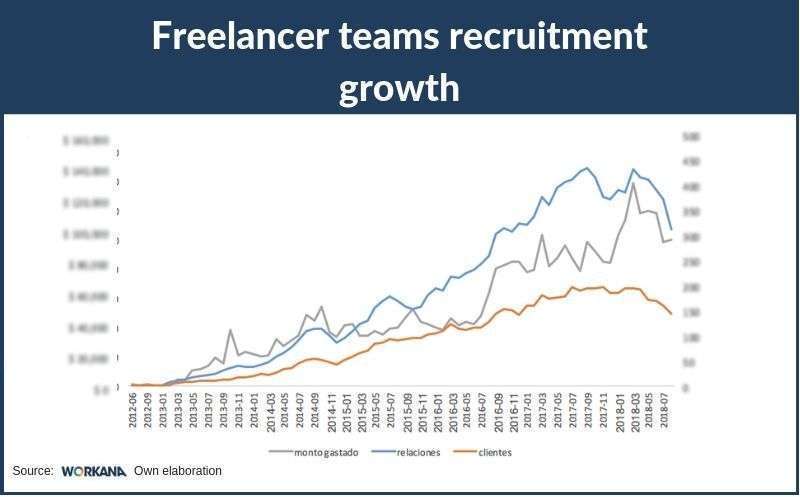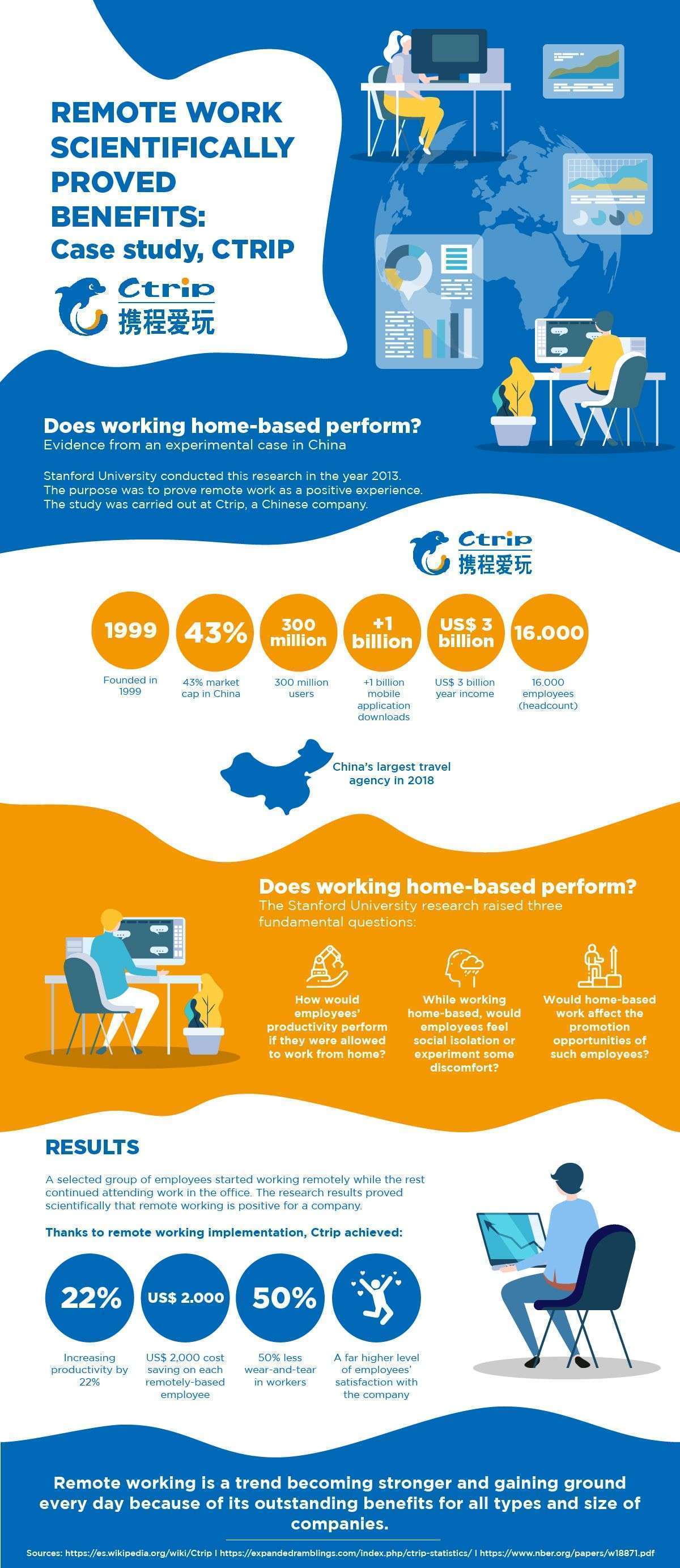Working teams which operate virtually are far from being a fad: they are the future both of multinational companies as well as small-scale enterprises and SMEs.
The evolution towards this new paradigm is already a reality in most first-world countries, like the USA, where more than 10% of the employees work home-based on a regular basis (National Bureau of Economic Research). Though Latin America is in the midst of undergoing a transitional and acceptance stage of the distance-work model, the fact that stands out is that freelance work is increasingly gaining ground.
Estimations claim that only in a given number of countries such as Colombia, freelance workers rate has increased 238% in the last four years. The following chart clearly shows how Workana has increased its freelancers hiring rate among clients, from the year 2013 until today.
Remote work is a tool which enables companies to remain competitive in an intensely globalized environment. At the same time, this carries its difficulties and fields of opportunity. Unfortunately, some companies chose to hold on to traditional schemes which prove less efficient -but still, known matter- instead of facing and overcoming the challenge of innovative and flexible work dynamics.
Notwithstanding the above, the ongoing freelance business is such, that even institutions of the stature of Harvard University, Stanford and Management Research, to mention but a few, are starting to carry out research and delivering specialized courses on how to increase productivity in remote working teams.
In preparing this article, we revised many papers on the subject and identified the difficulties most commonly faced by remote working teams worldwide, as well as the underneath causes and possible solutions.
Before entering on the subject matter, we will rapidly go through some of the numerous advantages hiring freelancers provides to grow up your business, leaning on serious, independent and objective research bases to support analyses.
Advantages of remote working teams, according to focused studies.
Rebekka Bakken, CEO of her marketing editor firm and member of Continuous Education in Harvard, is an enthusiast in all which regards remote working culture. In her opinion, virtual teams enable employees enjoying a healthier, free, and flexible balance between work and personal life. At the same time, this work model gives companies the possibility of building super efficient and specific-goal-oriented teams, while excluding labor ties.
A joint study conducted by researcher and Stanford University Professor Nicholas Bloom together with the Chinese firm Ctrip has discovered that volunteers who started working home-based during a nine-month period, reported the following benefits:
- increased their productivity rate by 13%
- reduced their number of sick-leaves
- felt they were working in a quieter environment
- expressed being more satisfied with the company
- suffered less number of dropouts
By the end of that period, provided such successful results, Ctrip offered the whole Enterprise staff the possibility to work home-based. Almost half of the company headcount chose this model, which resulted in increasing company profits by 22%.
An article published in Management Research News magazine cites the following advantages of virtual teams:
- Less time and expenses devoted to traveling issues
- Access to more qualified talent, regardless of geographical barriers
- Increased creativity and originality through diversity
- Promotion of a fairer and equitable working environment regarding opportunities
- Definite lack of motivation for discrimination based on racial, sex or age issues
Remote work is a labor scheme that benefits companies and workers alike. Thus, every day we see more and more institutions adopting this pattern.
Challenges of remote working teams and their solutions
Even though theoretical advantages of remote working teams are vast, in practical terms things do not run so smoothly in the day-to-day. Remote working teams are particularly vulnerable to communication, trust and performance problems when key elements such as leadership and technology failed in being optimal.
An on-off revision on many research studies conducted by academic and institution experts like Harvard, Jaypee Business School, and Georgia University, allow us to identify the seven main problems remote working model faces nowadays.

Lack of communication / underreporting
To begin with, keep in mind that both traditional and remote working teams are equally plausible in having communication problems. Communication is a complex phenomenon in which the sender, the nature of the information to be conveyed, channel and receipt, all influence alike.
When we deal with communication problems in teams working face-to-face, we analyze the causes underneath and search for solutions. However, when lack of communication shows up in remote teams, we quickly blame it on the distance-fact, claiming it to be an insurmountable obstacle. We tend to create resistance and mistrust towards this mode of work.
How can we resolve communication problems in remote working teams?
- Assess your partners’ communication skills: before hiring a remote worker, make sure he holds good communication skills, both written and orally. The person should be able to transmit complex ideas in an organized manner and, at the same time, absorb and sum up vast amounts of information.
- Promote communication-culture: create the habit of constant feedback within your team. Be explicit on how team members should communicate, offering guidelines: what kind of information should be shared, by what means and if possible, organize periodical face-to-face meetings once or twice a year. Giving positive and negative feedback to your freelancers is essential to growing improvement.
- Choose the best tools available: some free software will enable you to cover some communication and project management needs. You will probably require investment in technology to optimize your task flow. In Workana blog we have many articles regarding these tools, such as this note aimed to work meetings optimization through freelancers’ access to technology.
Lack of commitment and mistrust
Just like communication problems, mistrust may spring in traditional or remote teams alike. This sense may emerge when we feel that our colleagues are not committed enough to the project as expected. Lack of commitment may also take the scene when we don’t feel motivated enough or identified with the team.
Nevertheless, according to one Harvard University report, when it comes to virtual teams, preventive measures should be taken beforehand to build trust and connection among all the colleagues involved.
Out of a thousand employees surveyed, 52% pointed out that when working at their home office they feel that the rest of the team is less trustful and leave them out of some big decisions. More specifically, they worry that coworkers say bad things behind their backs and make changes to projects without telling them in advance, as a means to undermine their work.
When these situations take place, most managers decide to cancel remote work, stop hiring freelancers and push all their staff back to the office. The truth is, experts’ advice is to encourage habits that lead to feelings of trust, connection, and shared purposes instead of putting a reverse with virtual teams.
How can we bridge the trust gap in remote working teams?
- Keeping a clear mission/vision on your organization: Convey with the right words your company’s objectives will help you create identification channels with your colleagues. Keeping a clear vision in mind is particularly important when the road to your end goals is made on evolutionary steps. “Making life easier for vulnerable groups,” “to open new opportunities for technological development,” “encourage communication competitive quality” are examples of missions capable of assigning human and motivational meaning to your company’s projects.
A Korn Ferry Institute study found that the new generations rank high working in organizations with authentic purposes. At the same time, companies genuinely basing operations and organizational culture on their values achieve goals faster while their annual growth nearly triples the yearly rate for the whole sector.
As an example, Netflix’s unique organizational culture is one of the company’s key motors, basing its mission in becoming the best global entertainment service, and in promising its collaborators a chance to make a significant impact.
At Workana, more than half our employees work remotely from different countries, but we all pursue a common objective. The mission we work for every day is the following:
To transform the workplace, providing and enhancing people’s autonomy, development, and equitable opportunities wherever you are.
Moreover, we love doing that!
- Encourage collaboration and team building: when each team member is conscious about how their work and the others’ will affect the final result, and which are the difficulties and challenges faced by each of them, you enable a better comprehension of the process as a whole, while creating a sense of responsibility that will optimize work.
- Develop remote-leadership skills: socials scientists and researchers on the field of entrepreneurial performance Joseph Grenny and Daniel Maxfield, insist on the possibility of solving most of the mistrust issues happening in virtual teams by relying on leadership models. Later we will discuss some essential skills to lead projects adequately when we are to work with remote collaborators.
Obsolete or inadequate technology
Entirely all research and literature existing with regards to remote working teams agree on technological tools proper utilization is one of the critical elements to success in this working model. For the very same reasons, when technology responses are not adequate, or collaborators do not manage these tools, a whole series of communications and performance problems will begin to arise.
How can we overcome technical problems in remote working teams?
- Train all your staff in the use of technology: not only the members of your team must be familiar with and comfortable using technological tools considered necessary for their task dynamics, but all the rest of your staff should. In fact, in remote workplaces, a huge part of communication issues spring between remote collaborators and side-by-side ones.
- Invest in adequate technology: even though there are thousands of free options to satisfy a variety of needs, most projects imply specific technologies development, like API’s, CRM’s or just plain software licenses.
- Ensure that all your team has the right tools they need: One proper computer equipment plus an excellent connection to the Internet is something most remote workers may have. Nevertheless, a project may sometimes require more sophisticated tech tools. Instead of your complaining, assuming this is “worker business,” try to find a way to help him or her, to obtain those tools and work more productively.
- Keep updated: the fact that your team works well with their actual tools does not mean they cannot work even better if provided with the latest new tools available. Remote working teams are continuously evolving, just like the technology they use should also be.
Inadequate processes
Eventually, virtual teams faced the obstacle of having to follow inadequate or poorly efficient procedures designed by the very same institution on which they work. It is not rare that enterprises avoid taking the necessary time to adapt its processes to remote team inner dynamics, resulting in significant losses of time, motivation, and productivity.
How can institutional processes of traditional work-models be adapted to remote models?
- Priority on objectives, not on processes: not all the methods function equally with all working teams to meeting targets. Maybe your on-site workers find better to develop tasks in some particular manner, but don’t discard that your remote team may establish its own, which may prove more effective, to meet goals. Allow your remote team to agree on deciding what manners they found more suitable, and based on that, establish and optimize processes.
- Maintain constant optimization and monitoring: all those steps within the process which force remote workers to triangulate information, to revising the work of others or carry out activities outside their normal scope, to mention but a few, are not efficient parts of a process. Therefore, you are to find a way to cancel them or replace them.
On the other hand, many times you will need to integrate additional steps into an existing workflow to avoid occasional bottlenecks. That is why it is so important to keep an attitude focused on continuous optimization and opened to your teams’ advice on improvement strategies.
Lack of productivity and time mishandling
Many companies view home-based work as a threat to their control over their employees’ productivity. Of course, it is no news to see people not using time assertively when they are not under a permanent monitor. We should consider that this phenomenon is more the exception than the rule, especially when you collaborate with freelancers who are used to working virtually.
How can time mishandling be resolved in remote working teams?
- Measure work progress: without having to invade our collaborators’ privacy and time management, the best way to ensure that all people are fulfilling their tasks on time and correctly is to set clear objectives and deadlines.
One way to achieve this is by keeping track of the hours worked: this will give you a clearer insight into the time required to complete particular tasks, allowing realistic expectations on your team’s progress. There are tools such as Harvest or Toggl which may provide a track on hours. Workana also counts with a special program for this: the Workana Time Report, an easy way to auditing in real-time your remote collaborators’ performance in regards to hours.
- Institutionalize good practices: those -apparently- irrelevant details such as sending a file in the wrong format, resending everybody an email with an endless conversation attached or waiting for a coworker to ask for access to visualize some crucial data are things that, combined, reduce team’s productivity.
Therefore, agreeing on a check-list of good practices is an excellent way of establishing who is to send each part of the work without overloading other members or causing losses of time to the rest of the team.
- Discourage burn out: just as important as ensuring that everybody is doing their work and that team objectives are achieved, we are also to detect when one of our colleagues is taking on more load than he can manage healthily.
Abnormal behaviors, irritable moods, messages sent late at night or at dawn, and a sudden decrease in the standards of quality are all signs that your co-worker needs a break. Not reading those signs may lead to the risk of his losing motivations, commitment or even resign.
Geographical , cultural or ideological barriers
According to researchers Blaise Bergiel, Erich Bergiel y Phillip Balsmeier, remote working teams with members from different countries are very versatile but may also pose particular challenges deriving from origin diversity.
How can remote working team face geographical, cultural or ideological barriers?
- Different languages: even while all members may use the same common tongue such as English, members may have different commands on the word, leading to problems in communication.
Tip: Make your prospects sit for a professional exam on the language in which they will communicate. Provide training and courses for them to improve their communication skills on technical aspects or use experienced translators.
- Discordant time zones: while part of your team may be at their peak hour of productivity, the other may be sleeping, which implies inevitable delays in workflow.
Tip: set up delivery schedules with deadlines marked on fixed days and hours. This tip will avoid remote workers having to wait for hours to continue with their work.
- Cultural differences gap: establish a clear communicational code to be shared, based on respect, openness, and empathy. Get close to your colleagues for them to feel confident about sharing with you the cultural difficulties they may be facing.
Lack of leadership
Lack of leadership is one of the main problems virtual teams face, since many people in charge of a project may be great face-to-face leaders but have not developed the required skills needed to exerting remote leadership.
How can lack of leadership be overcome in remote working teams?
In the Harvard University survey mentioned before, participants were also asked to describe the profile of what they considered to be a particularly great manager in dealing with remote working teams. While some respondents said they had never run into such a kind, the others were able to identify the following vital attitudes:
- Frequent and consistent feedback: 46% of the surveyed pointed out good remote working team leaders give regular and personal input at least once a week.
- They rely on face-to-face or verbal communication: Good project leaders working with remote teams are concerned with scheduling video-calls or at least phone calls with collaborators whenever important subjects need discussion. They also promote team bonding, helping members to get to know each other thus exceeding a mere exchange of files or on chat.
- They have outstanding communication skills: they are perfectly able to convey complex ideas, specific expectations, abounding information and constant motivations to all the remote team. They are good listeners, cast confidence, respect and empathy and are personally concerned about their mates. They also encourage interpersonal communication and camaraderie.
Conclusion
Freelance work displays many advantages for companies and people. However, no work scheme is exempt from having its challenges and difficulties. Moreover, working with remote teams is either plain sailing all the time.
Nevertheless, the solution is not giving up on the bet on the virtual workplace, but developing good practices that allow us to get the highest potential from our remote colleagues. Soon, organizational competitiveness and life-quality of their workers will much depend on these strategies of assertive collaboration.
You can start building your own remote collaborators team in Workana, the leading platform in Latin America connecting you to the best freelance talents required to make your business grow while saving money.












